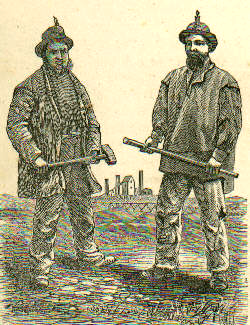

Vingoes Mining in Sennen
- - - - - - - - - - - - - - - - - - - - - - - - - - - - - - - - - - - - - - - - - - - - - - - - - - - - - - -
1703 AD:- Henry Vingoe's Tin Bounds.
There is very little history of mining in Sennen Parish. Whilst researching my Vingoe family line, George my husband visited the Courtney Library at the Royal Cornwall Institute in Truro and found a document dated 1703. This was issued by the Stannary of Penwith in the name of John Grenville who was the Custodian and Guardian of the Stannary. Other officers mentioned where Ephraim Weymouth and Noye Edwards. The document is signed William Cock.
The document is written in a shorthand Latin and also includes Cornish place names. If you click on the image you will be able to see a larger image.
George was lucky enough to have the help of the late Mr. H. L. Douch at the Institute who gave him a quick translation of the main points in the document.
The document is a License agreement on tin bounds at a place called Gweals Vean. Gweals is Cornish for field or place, whilst Vean means little. So the place referred to is Little Field at Trevescan in Sennen.
The bounds belonged to Henry Vingoe and he was letting them to William Borlase, the son of Joseph Borlase of St Just in Penwith. William Millett the son of Martin Millett also of St Just in Penwith and his own son Henry Vingoe Jnr. These bounds are bordered on the four sides by Carn Colwidrocke, Sowen Peddenantes, Vaan Vrease and Mean Sebmen.. The Date on the document is 1703.
Further research at the Courtney Library turned up a document entittled:-

1738 AD:- "A Survey of Tin Bounds, The Property of Sam. Borlase and Others."
The date on this document is 1783 and in it we found just one mention of the Parish of Sennen. This appertained to bounds owned by John Pascoe and others which were mined by S Borlase 1/3, I Millett 1/3 and A Pearce 1/3. There is included a sketch map of the bounds showing it to be on Trevescan Cliff. with the tin load being shown as running North to South going out to sea to the East of Dr Syntax's Head. These Bounds took in the whole of what we would refer to as the Lands End and included in this is land that was owned by a Israel Vingoe on the 1838 Sennen Tithe Map and labeled as No. 481. Israel also owned a field No. 547 which was known as Bellows & House Field.
1871:- TOOLS OF THE CORNISH MINER
The
Cornish miner had to find his way through rock of a very difficult character,
sometimes consisting of solid granite, or elvan rock of excessive hardness. His
tools were few, but they were well adapted to their job; consisting, besides
those represented in the following engraving, of a small wedge or two of steel,
denominated a 9ad, which is driven into the rock by the round end of
the pick, for the purpose of splitting and detaching portions from the mass.

1 2
The
instrument, No. 1, is the pick of the miner; 2, the shovel; 3, the sledge; 4,
the borer; 5, the claying bar; 6, the
needle, called by some the nail; 7, the scraper; 8, the tamping bar; and 9,the
tin cartridge, for blasting where the rock is wet: a horn to carry his
gunpowder, rushes to supply him with fuses, and a little touch-paper, or slow
notes on the coinage of tin
in devon and cornwall in 1595.
As
reported in the state papers of the Reign of Elizabeth 1st of England.
Vol.CCLIII.
July.
45. Note of the ordinary days of coining tin in Devonshire and
July.
46. Answers [by Thios. Myddletois I] to instructions concerning the coinage of
tin in Devonshire and Cornwall, Midsummer 1593. I have attended the coinage,
and, kept a book of the weights, but found no abuse. Midsummer coinage began at
Chagford, 12 June, and ended at Helstone, 9 July; but there is an after coinage,
at which the officers have 12d. for each piece of tin. Michaelmas coinage begins
15 September and lasts to 9 October, after which the accounts are delivered to
Wm. Nele, the Queen’s auditor. There is a part coinage about Christmas, the
Queen receiving 4 per cent, for licence, which is 001. a year, and the officers
12d. each piece of tin. Statement
1,3..1,SOlhs. The tinners cannot tell how much is exported, as merchants and pewterers sometimes deal for each other. It used to be all sent to France till the Ronen trade was stopped, and this price came down; then the Londoners bought for the Straits and the Low Countries; now it is sold in Turkey, France, and Flanders.
-----------------------------------------------------------------------